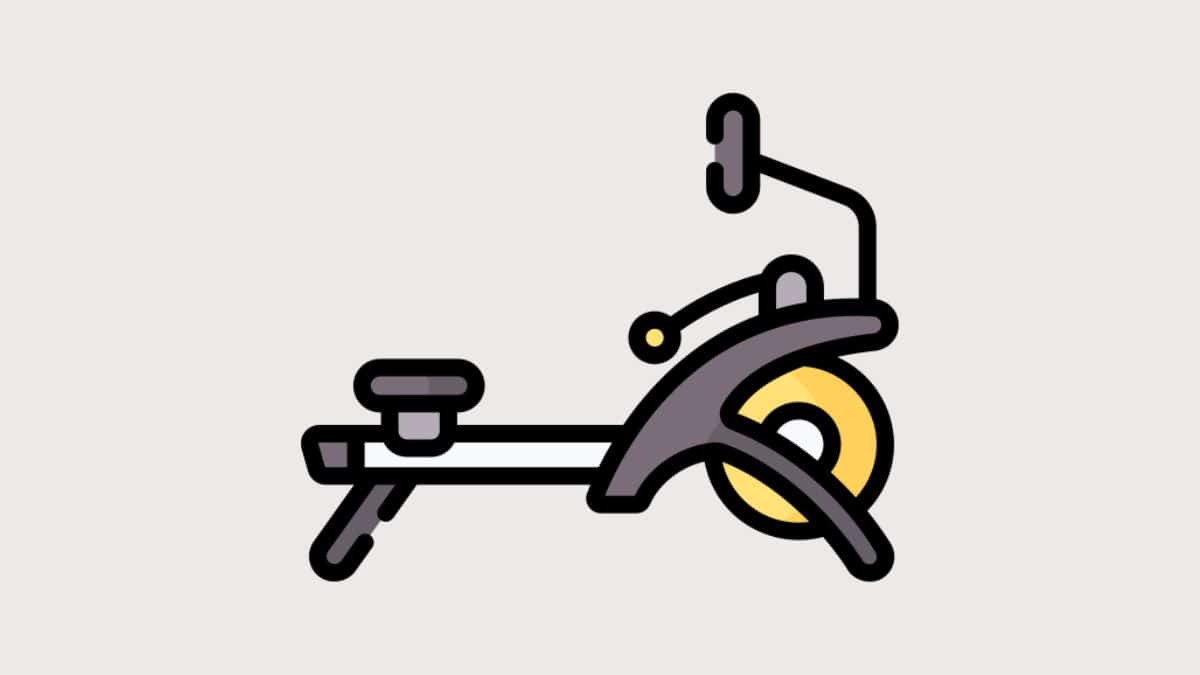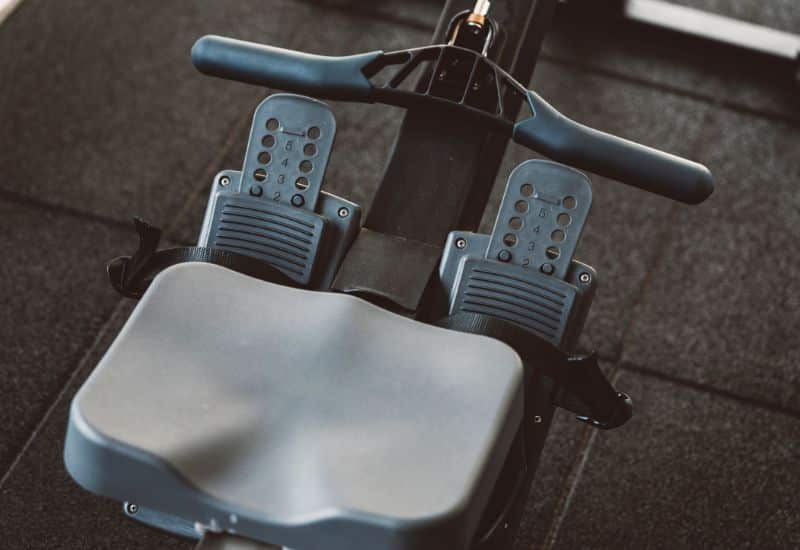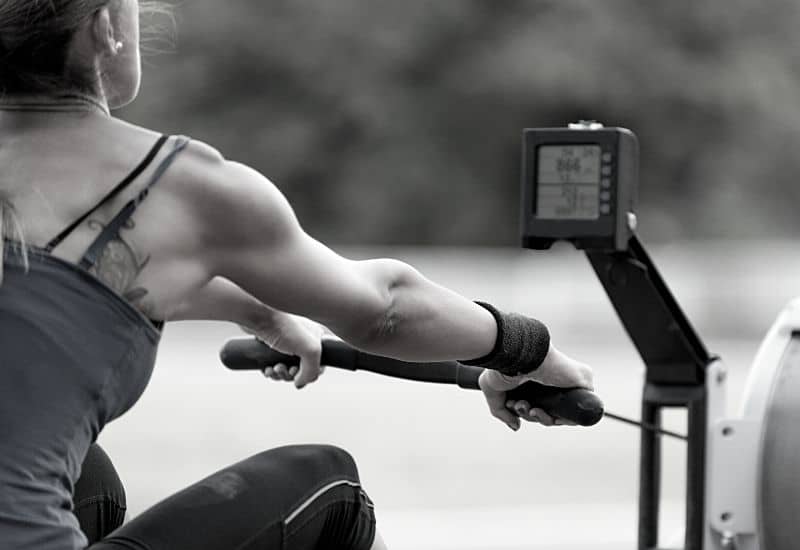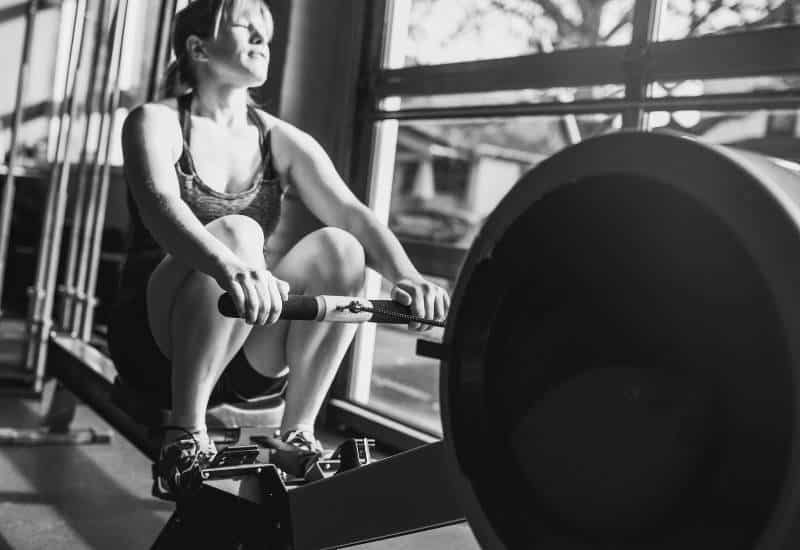Understanding rowing machine terminology helps you avoid common mistakes people make on the rower. Here’s your ultimate guide to rowing machine terms so that you can the most from your workouts.

The rowing machine is one of the best machines to use for weight loss and improved fitness—plus, it’s also one of the most fun.
I’ve talked a lot about the benefits of rowing machines in previous articles, as well as shared some of my favorite rower machine workouts for beginners and advanced trainees alike.
So in this post, I want to highlight a few of the key things you need to know about the rowing machine: the most important terminology you need to know, the metrics that help you track the effectiveness of your workout, and the different types of rowing machine workouts you can do.
I’ll even answer a few of the more commonly asked rowing machine questions at the end.
By the time you finish this post, you’ll be much more familiar with not only how to use a rowing machine, but how you can make the most of the time you spend training.
Let’s dive right in…
The Parts of a Rowing Machine
To begin, let’s talk about the various parts of the rowing machine:
Flywheel. This is usually a metal wheel with adjustable magnets that increase or decrease the resistance. The heavier the flywheel, the more effort is required to spin it when pulling on the handle.
Display. This is the screen (LCD or LED) that displays all the workout metrics (see the next section) that help you track your performance.
Footplates. This is the part where you strap in your feet, securing them so you can push backward through the “drive” phase, and pull yourself forward during the “recovery” phase (see more details about the phases below.

Seat. This is where you sit (pretty self-explanatory, I know). The seat is usually mounted on rollers and slides back and forth on the rail as you move through the rowing stroke. More padding = greater comfort.
Seat rollers. These are wheels or bearings that allow the seat to slide back and forth on the rail.
Rail. This is the central beam along which the seat slides forward and backward. Typically, it’s made of stainless steel and is well supported on both ends to maintain stability.
Handle. This is the bar you grip in both hands, secured to the flywheel mechanism by a chain or cable.
Adjustor. Set into or connected to the flywheel, there is usually an adjustor lever or dial mechanism that lets you raise or lower the difficulty of the workout as desired.
Wheels or casters. These are typically integrated into the flywheel end of the rowing machine, used to make it easy to move your rowing machine around without scuffing or scraping the ground/floor.
Now that you know about all the parts of the rowing machine, here is some important terminology you need to know about:
Erg or Ergo. This is short for “ergometer”, another name for the rowing machine itself. The ergometer is the earliest indoor machine used to track rowing performance, and has been modified and adapted into what we know now as the modern rowing machine for weight loss.
Folding model. This refers to any rowing machine that is designed to fold up, usually where the rail meets the flywheel.
Standing model. This refers to any rowing machine that doesn’t fold, but can be stood up on its flywheel end to reduce footprint when not in use.

Heart rate monitor. Typically, rowing machines will have a heart rate monitor of some sort: either integrated into the handles or connected via wrist or chest strap. Tracking heart rate is crucial for determining energy output and workout performance (see the next section for more details).
Rowing stroke “phases”. This refers to the four different parts of the rowing movement:
- The Catch, or set-up at the beginning of each rowing stroke.
- The Drive, wherein you push backward with your legs and pull the handle to your torso.
- The Finish, the end of the stroke when your legs are fully extended and the handle is touching your torso.
- The Recovery, wherein you slide forward, extend your arms, and bend your knees to return to your starting position.
Time trials. In a time trial, you row to a certain distance (for example, 1,000 meters) with a specific time goal, or row for a specific timeframe (for example, 5 minutes) and see how far you can row.
Rowing Machine Terminology — Workout Metrics
When using the rowing machine, the display will show you a few metrics that are important to track in order to determine just how effectively you are working out. These metrics include:
Watts. This is the amount of energy you’re producing per stroke. Higher wattage means greater intensity in the drive phase of the rowing stroke, which can lead to longer distances traveled per stroke and increase your overall distance without speeding up your stroke rate.
Stroke rate, or SPM. This is the number of strokes per minute. As I explained in my rowing machine stroke rate article, SPM is a crucial metric that allows you to track your rowing speed and row faster or slower depending on how you feel throughout the workout.
Calories. Calories burned refers to the amount of energy you’re expending overall. The harder and faster you row, the more calories are burned on the rowing machine.
Heart rate. The heart rate metric will let you know how hard you’re pushing yourself, whether you’re working at a low-intensity (typically in the 55 to 65% MaxHR range), moderate intensity (between 70 and 85% MaxHR), or high intensity (85% and higher).
Typically, for weight loss, you work in the low-to-moderate-intensity range, whereas for improving your heart rate and aerobic capacity, you work in the high-intensity range.

Distance. This tells you how far you’ve rowed over the course of your workout. Typically, you can calculate the distance per stroke based on how far you’ve traveled during one minute, divided by the SPM (stokes per minute) rate for that duration. That can tell you how many minutes you need to row to hit a certain distance, helping you know if you need to speed up for a time trial or row harder to increase wattage.
Speed. Your rowing speed is usually marked in knots, a nautical measurement of speed. However, you can often change it to mark the speed in kilometers or miles per hour.
Split time. Split time refers to how much time it would take you at your current SPM to row a specific distance. Typically, split time will be marked either in 200-meter or 500-meter distances. You’ll see numbers like 2:11/500, which means it will take you 2 minutes and 11 seconds at your current speed and intensity to row 500 meters.
Split time is a useful metric to help you set your pacing for longer rowing workouts. Once you’ve used this cardio machine for weight loss workouts for a dozen or so training sessions, you’ll have a good idea what your current pace is (either in SPM or time-to-distance), and you can monitor your split time to make sure you’re rowing at the correct pace.
The Different Types of Rowing Machine Workouts
There are a few different approaches to training on the rowing machine, different types of workouts that can help you make the most of the time you spend rowing. Below, I’ll talk about a few of the most common ones:
HIIT/Tabata
“HIIT” is an acronym for “high-intensity interval training.”
A rowing machine HIIT workout involves periods (or intervals) of high-intensity effort, interspersed with periods of low-intensity effort.
The combination of the two gives you the opportunity to push your body to its maximum capacity (muscular and aerobic). However, you can only sustain maximum output for a short time before your body needs oxygen to recover. This is where the low-intensity interval comes in, giving your body that time to recover.
There are many approaches to HIIT:
- 30 seconds of high-intensity effort followed by 120 seconds of low-intensity effort (better-suited to beginners)
- 30 seconds of high-intensity effort followed by 60 seconds of low-intensity effort (better-suited to more intermediate-level trainees)
- 30 seconds of high-intensity effort followed by 30 seconds of low-intensity effort (better-suited to advanced trainees)
- 60 seconds of high-intensity effort followed by 30 seconds of low-intensity effort (better-suited to expert-level trainees)
You can perform as many repetitions of these cycles as you want/can.
With the Tabata method created in Japan, there’s a very specific approach to training:
- 20 seconds of high-intensity effort
- 10 seconds of recovery
- 8 cycles, repeated for a total of 4 minutes
Typically, Tabata is used for workouts that involve a lot of variety—for example, workouts that involve many different exercises. For the rowing machine, you can use Tabata to do 4 minutes of HIIT rowing, then switch to another exercise (such as push-ups or resistance training), then come back to the rowing machine for more Tabata cycles.
Low-Intensity, Steady-State
Low-intensity, steady-state (LISS) workouts involve a (largely) unchanging pace, typically one that involves fairly low-intensity effort. You’ll usually work in the 55 to 70% heart rate range, rowing at a pace you can sustain for anywhere from 25 to 60 minutes.
LISS workouts are good for long-term effort and greater activation of stored fat to burn for energy. Your body needs sufficient oxygen to utilize fats for energy, so the low-intensity exercise ensures your lungs can oxygenate your blood enough that fats can be used (rather than the glucose-based energy burned during high-intensity exercise).
And, because you’re working at low intensity, you can typically sustain the pace for longer. Over the course of a 30, 45, or 60-minute workout, you can burn as many or more calories than a 15 or 20-minute rowing machine HIIT workout.
The calories burned will also be primarily fat-based, making it the best way to use the rowing machine for weight loss, leading to good long-term weight and fat loss.
Time Trials
Time trials are all about hitting a certain goal in a certain time frame.
There are two approaches to time trials:
- Rowing for a predetermined amount of time (2 minutes, 5 minutes, 20 minutes, etc.) and seeing how much distance you can cover in that time.
- Rowing a pre-determined distance (200 meters, 500 meters, 2,000 meters, etc.) in the shortest possible time.
Time trial workouts are all about the clock, and they can be a lot of fun for people who like to challenge themselves to work harder and need visible results they can track and compare with every workout.
Ladder and Pyramid Workouts
Ladder workouts use escalating SPM, wattage, or split time to continually push your body to row harder. An example of a ladder workout would be:
- Row 1 minute at 22 SPM
- Row 1 minute at 23 SPM
- Row 1 minute at 24 SPM
- Row 1 minute at 25 SPM
- Row 1 minute at 26 SPM
- Row 1 minute at 27 SPM
- Row 1 minute at 28 SPM
- Row 1 minute at 29 SPM
- Row 1 minute at 30 SPM
What this does is start you off at a low or moderate pace, but gradually increases the pace until you’re rowing at maximum speed/capacity. Because there is a gradual increase, your body is better-able to maintain the faster pace without fatiguing, but you burn more calories than you would maintaining a slower pace.
Typically, these ladder workouts are time-controlled (you row for 1-2 minutes at each “rung” of the ladder) and only end when you reach fatigue (you just can’t row any more).
Pyramid workouts are similar to ladder workouts, with one crucial difference: they also descend.
Ladder workouts are ascendant; you keep rowing faster and faster until you’re done. Pyramid workouts increase your speed until they hit a goal (say, 30 SPM, as demonstrated in the example above), but then descend at the same 1-minute/1 SPM interval until you reach your starting rowing speed.
Because you have to sustain the higher-intensity effort for longer, pyramid workouts may not reach speeds as high as ladder workouts, and will definitely be more tiring (and burn more calories).
Rowing Machine Terminology – FAQs
Why are rowing machines called ergs?
The name “erg” is short for “ergometer”, the name of the machine that was originally built for rowers to use as a controlled means of monitoring their rowing performance.
The ergometer was eventually adapted into what we now know as the modern rowing machine.
What is the best way to measure a rowing machine workout?
Typically, SPM is the best metric to use to measure your workouts. Lower SPM means a slower rowing speed, while higher SPM means you’re rowing faster.
As long as you’re maintaining the proper form throughout, it’s a highly useful metric to measure your performance.
The Bottom Line
Now that you’ve read this post, you know pretty much everything you need to know about rowing machine terminology, the various parts of the rowing machine, and the typical rowing machine workouts.
Time to take that knowledge to the gym (or your home gym) and start working hard.
You’ll find that switching up the workouts I mentioned above and incorporating all of them into your regular training will lead to the best long-term results possible—both in terms of your fitness and your weight loss.